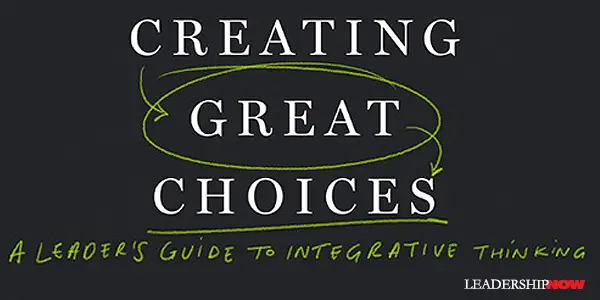 |
 |
02.13.18

Creating Great Choices
O If we understand that we all have different mental models—our view of how the world works—we use those various models to improve our own. Once we see things in a certain way, it becomes very difficult to see things in a new way. Integrative thinking is a method to do just that. Roger Martin introduced the practice of integrative thinking in his book, The Opposable Mind. “The opposable mind is one that can use the tension between a set of ideas to create new and superior answers to challenging problems. This follow-up book, written by Martin and adjunct professor Jennifer Riel, Creating Great Choices, provides the methodology to do just that. Martin finds that there are three elements missing from most decision-making processes: metacognition, empathy, and creativity. When employed, metacognition allows us to understand better our own thinking and existing mental models that influence our decisions and the choices available to us. Empathy allows us to understand the thinking of others, which in turn illuminates the gaps in our own thinking and areas where we might connect with others. Finally, creativity provides the imaginative spark to create new and better choices rather than just accepting the options held in tension before us.
Articulate the Models Step one is to Articulate the Models, that is “to frame the problem and tease out two opposing models for solving it.” What are the core elements of each model? The idea is to create a two-sided dilemma from a general problem like whether to use a centralized structure versus a decentralized structure or consumer needs versus shareholder expectations. Ultimately you will not choose between the two, but to use the two models or approaches to create a better choice. The outcome we will look for, won’t be a compromise between the two choices, but a choice that takes the best of both that will produce an outcome that is preferable to the existing ones. Examine the Models Step two is to Examine the Models. While holding them in tension, define the points of tension between the two models or approaches, illuminate the assumptions, and determine the cause-and-effect forces. As you look at the models, ask, what are the forces that drive the most important outcomes or the benefits we most value of each? How might we change how we think about the approach? What is similar? What is different? What benefit would you be loath to give up from each model? Now you want to shift from understanding the models to creating new models, “creatively building from both opposing models to design an answer that is ultimately superior to either one.” Examine the Possibilities So in step three, you Examine the Possibilities. Explore other resolutions. Here there are three directions you might go to find a better choice: the hidden gem, the double-down, or the decomposition. In the Hidden Gem, you take “one deeply valued benefit from each of the opposing models and throw away the rest. You imagine a new approach designed around the two gems.” And “you will need to replace all of the elements you’re throwing away with something new.” “I want one small element of A and B.” In the Double-Down, causality is key. If you identify one of the models as the one you would choose if it just weren’t missing one critical element, you Double-Down. “I want all of A and one key element of B.” In Decomposition, you do both—two contradictory things at once. You will need to “reach a different understanding of the problem you’re trying to solve.” In other words, you will need to break the problem apart and apply one solution to each. “I want all of both.” Assess the Prototypes Finally, in step four Assess the Prototypes to test different possible answers to find an answer that can actually be implemented. Proving an idea that is new is possible only in theory. A new model is possible only if we think differently. “At this stage, gaps in logic are necessarily the sign of a bad idea; rather, they are the hallmark of a new one. Gaps represent an opportunity to clarify and refine what a possibility could be. Possibilities become richer as they become more concrete because there is less abstraction within which to hide.” They recommend that when trying to communicate a new idea, try using storytelling, visualizing, or modeling—words, pictures, and/or objects. Look for ways to disprove the idea or under what conditions might it not work. In this way, you can finds ways to strengthen the idea. What Is Your Stance? Going into any decision-making process, you need to understand your stance—where you are coming from—who you are and what you are trying to do. What informs your thinking? Different stances drive different outcomes. As a leader, your job is to be clear about your own thinking, knowing that your own models or views of the world are at least a little bit wrong. Understand others view of the world to inform and improve your own. And patiently search for answers that resolve the tension between opposing ideas to find the opportunities to create better choices. Integrative thinking isn’t for every problem you face. “But when you find that your conventional thinking tools are not helping you to truly solve a problem, integrative thinking can be the tool that shifts the conversation, defuses interpersonal conflicts, and helps you move forward.” Martin and Riel have included in this integrative thinking user’s guide, templates to help you work through each of the four steps. Keep it handy. 
Posted by Michael McKinney at 09:49 PM
|
BUILD YOUR KNOWLEDGE
 

How to Do Your Start-Up Right STRAIGHT TALK FOR START-UPS 
Grow Your Leadership Skills NEW AND UPCOMING LEADERSHIP BOOKS 
Leadership Minute BITE-SIZE CONCEPTS YOU CAN CHEW ON 
Classic Leadership Books BOOKS TO READ BEFORE YOU LEAD |